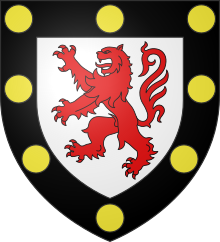Aimery I de Rouchefoucould (d. 1151), was the Viscount of Châtellerault and father of Aenor de Châtellerault. Through his daughter he was the grandfather of Eleanor of Aquitaine, who would become Duchess of Aquitaine (in her own right) as well as queen of both France and England. Eleanor was arguably the most celebrated woman in Medieval European history.

Family
editAimery was born to Boson II de Châtellerault and his wife, Aleanor de Thouars. His paternal grandparents were Hugues I de Châtellerault and his wife, Gerberge. His maternal grandparents were Aimery IV, Viscount of Thouars and Aremgarde de Mauléon.
Through his granddaughter, Eleanor, Aimery was an ancestor of various nobles and monarchs including: Richard I of England, Marie, Countess of Champagne, John of England, Geoffrey, Duke of Brittany, Joan, Queen of Sicily, Eleanor, Queen of Castile, Matilda, Duchess of Saxony and Henry the Young King.
Life
editMarriage
editAimery was married to Amauberge, called la Dangereuse, the daughter of Barthelemy de L'Isle Bouchard and his wife Gerberge de Blaison. Their marriage produced at least three children:
- Hugh, his father's heir to the viscounti
- Raoul became the lord of Fay-la-Vineuse through his marriage to Elisabeth de Faye
- Aenor(c. 1103 – March 1130) married William X, Duke of Aquitaine, mother to Duchess Eleanor and Petronilla and the short lived William Aigret.
Eleanor of Aquitaine was known to have been quite fond of her maternal uncles, Hugh and Raoul, and granted them during her two tenures as queen of France and then of England.
The Affair
editIn 1115, after seven years of marriage, Amauberge was literally "abducted" from her bedchamber by William IX, Duke of Aquitaine. She was taken to a tower in his castle in Potiers called Maubergeonne. As a result, Amauberge or Dangereuse was nicknamed La Maubergeonne. Abductions like these were quite common among nobles during the Middle Ages. However, in this particular case it seems to have been a willing contributor to the affair.
The Duke of Aquitaine, known to history as being the first troubadour was quite popular with the women of his time and was known to have had many affairs. However, the Viscountess would become his mistress for the rrest of his life. There is no record of complaint by Aimery. This is believed to be because the Viscount feared the rath of his powerful and volatile overlord. It would be the Dukes wife, Philippa of Toulouse who took action against the "abduction" and affair. Her actions would lead to both the William and Dangereuse being excommunicated by the Pope. William used his wealth and power to eventually reconcile with the Pope and was excepted back into the Church.
In 1121 Aimery and Dangereuse's daughter would marry William IX's son and heir, who would become Duke William X of Aquitaine. It's is believed that this union came about by Dangereuse's uring. Historians don't see another reason for the union of such a powerful man to the daughter of a minor vassal. Not only that, but Aenor was the daughter of the woman the future duke hated for role in the treatment of his mother. Despite the cause, the marriage led to the birth of Eleanor of Auitaine and made Aimery an ancestor of some of the most famous European nobles and rulers since.
Footnotes
edit.
Bibliography
edit- Markale, Jean. Eleanor of Aquitaine: queen of the troubadours. Rochester, Vt.: Inner
Traditions, 2007. Print.
- Paden, Wiliiam D.. "The Troubadour's Lady: Her Marital Status and Social Rank." Studies in
Philosophy 72.1 (1975): 28-50. JSTOR. Web. 14 Nov. 2010.
- Painter, Sidney. "The Houses of Lusignan and Chatellerault 1150-1250." Speculum 30.3(1955):374-384. JSTOR. Web. 14 Nov. 2010.
- Swabey, Ffiona. Eleanor of Aquitaine, courtly love, and the troubadours . Westport, Conn.: Greenwood Press, 2004. Print.
- Weir, Alison. Eleanor of Aquitaine: a life. New York: Ballantine Books, 2000. Print.